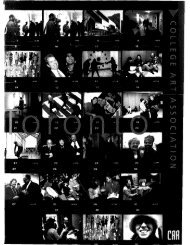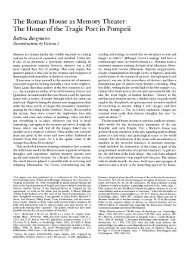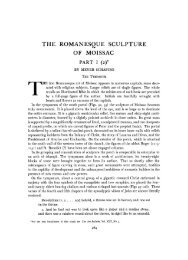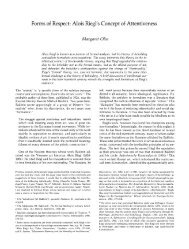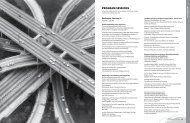THE HUMANISTIC THEORY OF PAINTING - College Art Association
THE HUMANISTIC THEORY OF PAINTING - College Art Association
THE HUMANISTIC THEORY OF PAINTING - College Art Association
Create successful ePaper yourself
Turn your PDF publications into a flip-book with our unique Google optimized e-Paper software.
UT PICTURA POESIS: <strong>HUMANISTIC</strong> <strong>THE</strong>ORY <strong>OF</strong> <strong>PAINTING</strong> 207<br />
The cult of the antique produced then in the sixteenth century an important modifica-<br />
tion of Aristotle's theory of imitation that had far-reaching results. For Aristotle himself<br />
had not counseled the imitation of models, but clearly believed that significant imitation<br />
of nature is a function of the selective imagination and does not fundamentally depend<br />
on any external norm of perfection like the antique. Nor did Aristotle in his profound doc-<br />
trine of the imitation of a superior nature mean that the artist should turn from nature<br />
herself, who must always provide fresh materials for selective imitation, to an a priori Idea<br />
of perfection in his own mind. But near the end of the century a Neo-Platonic critic like<br />
Lomazzo could temporarily divert the theory of imitation entirely from Aristotelian chan-<br />
nels by declaring that ideal beauty, the image of which one sees reflected in the mirror of<br />
his own mind, has its source in God rather than in nature-a quasi-religious and mystical<br />
doctrine in harmony with the serious temper of the Counter-Reform, and one that did not<br />
empirically find a standard of excellence in selecting the best from concrete and external<br />
nature, but discovered it in Platonic fashion in the subjective contemplation of an inward,<br />
immaterial Idea.48 But in 1664, in the secularizing age of the high Baroque, Giovanni<br />
Pietro Bellori resumed and brought to fruition what had been until the late sixteenth cen-<br />
tury the normal Italian mode of thinking about the arts.49 Before Bellori wrote, this habit<br />
of mind, by nature empirical yet possessing a deep, qualifying strain of idealism, had<br />
found in the realm of aesthetic philosophy only hesitant and tentative expression. Alberti<br />
and Vasari, and one may include Raphael in a famous letter to Castiglione, had all associ-<br />
ated the Idea that raises art above the mere imitation of things with direct experience of<br />
nature;50 but their utterances on the subject are naive or fragmentary, and are valuable<br />
less as contributions to aesthetic than as interesting reactions of a receptive and sensitive<br />
artist and of two distinguished writers on art (who were also artists in their own right) to<br />
philosophical ideas of their age-ideas of which they were sympathetically aware, but which<br />
they had considered in none too philosophical a manner. And although Dolce, who does<br />
48. Compare, for instance, Varchi's use of the word<br />
discrezione (see note 40) to suggest merely that the artist<br />
should alter and improve the raw material of nature with<br />
Lomazzo's very different and highly significant use of it in<br />
his last work, Idea del tempio della pittura, Milan, 1590,<br />
12-14, where as a result of Neo-Platonic influences near<br />
the end of the sixteenth century, the term is used to mean<br />
that inner perceptive faculty of the artist which enables<br />
him to behold in his own mind the emanation of the su-<br />
preme Idea of beauty which is in God, and to discern in<br />
this emanation the standard of perfect art. This theory<br />
of imitation differs fundamentally from the earlier theory<br />
of Dolce who finds an outward standard of perfection in<br />
the antique, not an inward standard in the image of ideal<br />
beauty in the mind's eye. The locus classicus, however, for<br />
Lomazzo's Neo-Platonism is chapter xxvi of the same<br />
book, entitled "Del modo di conoscere e constituire le<br />
proporzioni secondo la bellezza," in which, following<br />
Ficino's famous commentary on Plato's Symposium, he<br />
develops the theory that earthly beauty is an immaterial<br />
emanation of the divine beauty which the artist recognizes<br />
only because he is aware of the reflection of the divine<br />
beauty in his own mind (see Panofsky, Idea, pp. 52-56; for<br />
the reprinted texts of Ficino's commentary and Lomazzo's<br />
chapter ibid., pp. 122-30; see note Io8).<br />
49. L'idea del pittore, dello scultore e dell'architetto, a lec-<br />
ture given before the Accademia di San Luca in Rome in<br />
1664 and printed in 1672 as introduction to his Vite de'<br />
pittori, scultori et architetti moderni.<br />
5o. Alberti was aware of the concept of selective imita-<br />
tion: he tells the famous story of Zeuxis; his statement that<br />
"the Idea of the beautiful escapes the inexperienced artist"<br />
(Della pittura, p. i5I) is typical of an age that associated<br />
artistic achievement with experiment and practice. Raphael<br />
writes in 1516 to Castiglione that if he will paint a beautiful<br />
woman, it is necessary to see many beautiful women, but<br />
since there is a scarcity of handsome models, he makes use<br />
of a certain Idea that comes into his mind. This Idea or<br />
mental image of beautiful womanhood he probably associated<br />
with his experience of the individual beauty of women,<br />
but he cannot be said to have had in mind any very definite<br />
approximation of Aristotle's theory of the selective imitation<br />
of nature. The Idea may also have had some association<br />
in his mind with the Platonic idea of absolute beauty<br />
about which he could have heard much from Castiglione<br />
and others, but, again, writing as an intuitive artist, not<br />
as a humanist or philosopher, he does not say so. Vasari's<br />
remarks on the Idea (Introduction to the 1568 edition, pp.<br />
168 ff.) have been explained by Panofsky to mean that it is<br />
derived empirically from experience of nature. But Vasari<br />
was no theorist and cannot be said to have given much<br />
thought to the classical doctrine of imitation. See the important<br />
discussion of the concept of the Idea during the<br />
Renaissance in Panofsky, Idea, pp. 23 ff. Panofsky cites<br />
and discusses all of the passages mentioned here. Friedlaender's<br />
Neo-Platonic interpretation of the passage in<br />
Vasari in his review of Panofsky's Idea (Jahrbuch fiir<br />
Kunstwissenschaft, vI, 1928, 61-62) in my opinion overemphasizes<br />
the importance of what rather appears to be a very<br />
slight adumbration of Neo-Platonic theory.



